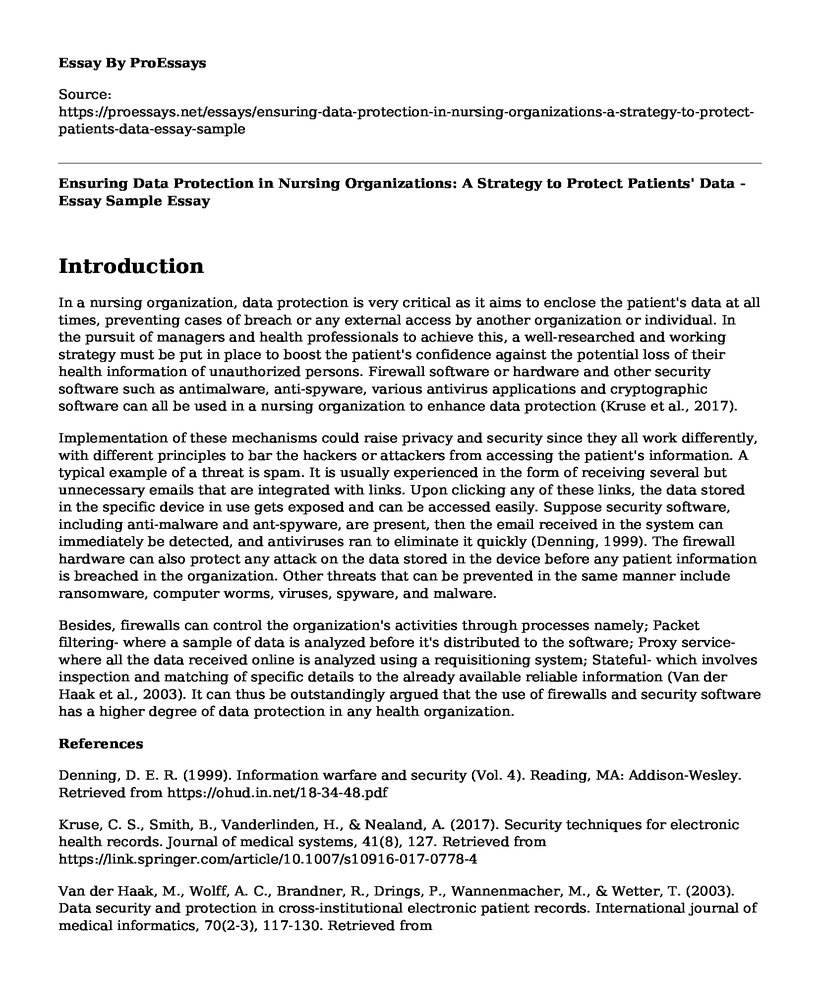Introduction
In a nursing organization, data protection is very critical as it aims to enclose the patient's data at all times, preventing cases of breach or any external access by another organization or individual. In the pursuit of managers and health professionals to achieve this, a well-researched and working strategy must be put in place to boost the patient's confidence against the potential loss of their health information of unauthorized persons. Firewall software or hardware and other security software such as antimalware, anti-spyware, various antivirus applications and cryptographic software can all be used in a nursing organization to enhance data protection (Kruse et al., 2017).
Implementation of these mechanisms could raise privacy and security since they all work differently, with different principles to bar the hackers or attackers from accessing the patient's information. A typical example of a threat is spam. It is usually experienced in the form of receiving several but unnecessary emails that are integrated with links. Upon clicking any of these links, the data stored in the specific device in use gets exposed and can be accessed easily. Suppose security software, including anti-malware and ant-spyware, are present, then the email received in the system can immediately be detected, and antiviruses ran to eliminate it quickly (Denning, 1999). The firewall hardware can also protect any attack on the data stored in the device before any patient information is breached in the organization. Other threats that can be prevented in the same manner include ransomware, computer worms, viruses, spyware, and malware.
Besides, firewalls can control the organization's activities through processes namely; Packet filtering- where a sample of data is analyzed before it's distributed to the software; Proxy service- where all the data received online is analyzed using a requisitioning system; Stateful- which involves inspection and matching of specific details to the already available reliable information (Van der Haak et al., 2003). It can thus be outstandingly argued that the use of firewalls and security software has a higher degree of data protection in any health organization.
References
Denning, D. E. R. (1999). Information warfare and security (Vol. 4). Reading, MA: Addison-Wesley. Retrieved from https://ohud.in.net/18-34-48.pdf
Kruse, C. S., Smith, B., Vanderlinden, H., & Nealand, A. (2017). Security techniques for electronic health records. Journal of medical systems, 41(8), 127. Retrieved from https://link.springer.com/article/10.1007/s10916-017-0778-4
Van der Haak, M., Wolff, A. C., Brandner, R., Drings, P., Wannenmacher, M., & Wetter, T. (2003). Data security and protection in cross-institutional electronic patient records. International journal of medical informatics, 70(2-3), 117-130. Retrieved from https://www.sciencedirect.com/science/article/pii/S1386505603000339
Cite this page
Ensuring Data Protection in Nursing Organizations: A Strategy to Protect Patients' Data - Essay Sample. (2023, Apr 05). Retrieved from https://proessays.net/essays/ensuring-data-protection-in-nursing-organizations-a-strategy-to-protect-patients-data-essay-sample
If you are the original author of this essay and no longer wish to have it published on the ProEssays website, please click below to request its removal:
- Cooperate Philanthropy Essay
- The Public Health Significance Paper Example
- The New Public Health Paper Example
- Paper Example on Enhanced Performance in Emerging Pharmaceuticals: Changes for Improved Efficiency
- Gays & Bisexuals: The High Risk of HIV/AIDS & Lack of Funding - Essay Sample
- Essay Example on Unhealthy Eating Habits: Please Do Not Feed the Humans
- Teaching Children with Disabilities - Free Paper Sample







